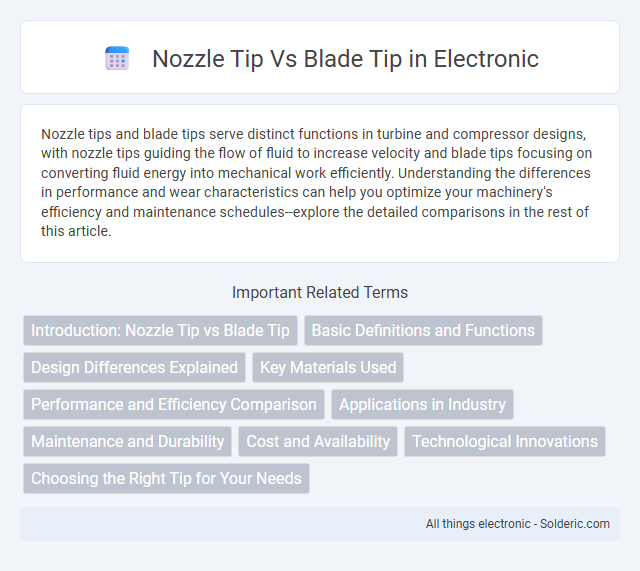Nozzle tips and blade tips serve distinct functions in turbine and compressor designs, with nozzle tips guiding the flow of fluid to increase velocity and blade tips focusing on converting fluid energy into mechanical work efficiently. Understanding the differences in performance and wear characteristics can help you optimize your machinery's efficiency and maintenance schedules--explore the detailed comparisons in the rest of this article.
Comparison Table
| Feature | Nozzle Tip | Blade Tip |
|---|---|---|
| Design | Conical or tapered tip focusing fluid flow | Flat or sharp edge designed for cutting or scraping |
| Primary Use | Directing fluid or gas flow precisely | Cutting, slicing, or scraping materials |
| Applications | Spray systems, fuel injectors, pressure washers | Cutting tools, turbines, mixers |
| Material Impact | Minimal mechanical contact, focused fluid force | Direct mechanical contact, shear force applied |
| Efficiency | Optimized for fluid velocity and spray pattern | Optimized for cutting precision and durability |
| Maintenance | Requires cleaning to prevent clogging | Requires sharpening and damage inspection |
Introduction: Nozzle Tip vs Blade Tip
Nozzle tips and blade tips serve distinct functions in turbine and compressor systems, impacting efficiency and performance. Nozzle tips are designed to direct high-pressure fluid flow precisely onto the blade surfaces, optimizing energy transfer and reducing flow separation. Blade tips, however, influence aerodynamic characteristics and leakage control, playing a crucial role in maintaining overall stage efficiency and minimizing mechanical wear.
Basic Definitions and Functions
A nozzle tip directs fluid flow into the turbine or compressor, converting pressure energy into kinetic energy for efficient operation. Blade tips, located at the edge of turbine or compressor blades, interact with the fluid to transfer energy between the fluid and the rotating shaft. The precise design of both nozzle tips and blade tips ensures optimal aerodynamic performance and minimizes energy losses in turbomachinery.
Design Differences Explained
Nozzle tips feature a fixed geometry that directs fluid flow precisely to maximize velocity and pressure, commonly used in turbines and jet engines for optimal energy conversion. Blade tips, in contrast, are integral parts of rotating blades with aerodynamic shaping designed to minimize tip leakage and reduce drag, enhancing overall efficiency in compressors and fans. The primary design difference lies in the nozzle tip's role in flow control and pressure management versus the blade tip's focus on aerodynamic performance and structural durability.
Key Materials Used
Nozzle tips are primarily crafted from high-performance alloys such as Inconel or stainless steel, chosen for their excellent heat resistance and durability in turbine environments. Blade tips typically incorporate advanced ceramic coatings or thermal barrier materials to withstand extreme temperatures and reduce wear caused by friction. Your choice between nozzle tip and blade tip materials is crucial for optimizing turbine efficiency and lifespan.
Performance and Efficiency Comparison
Nozzle tips provide higher thermal efficiency by directing exhaust gases precisely onto turbine blades, maximizing energy extraction and improving overall engine performance. Blade tips, while essential for aerodynamic lift and reducing tip leakage, typically result in slightly lower efficiency due to increased aerodynamic losses and less focused gas flow. Your choice between nozzle tip and blade tip design directly impacts turbine efficiency and power output optimization.
Applications in Industry
Nozzle tips are essential in industries like aerospace and manufacturing for precise fluid or gas flow control, improving efficiency in processes such as fuel injection and cooling systems. Blade tips, commonly used in turbines and compressors, optimize aerodynamic performance and reduce energy loss by minimizing tip leakage and enhancing overall system efficiency. Your choice between nozzle tip and blade tip depends on whether fluid control precision or mechanical aerodynamic performance is prioritized in the industrial application.
Maintenance and Durability
Nozzle tips generally offer easier maintenance due to their simple design and replaceable nature, which reduces downtime and extends overall service life. Blade tips, while often more durable because of their robust construction and resistance to wear, may require more specialized upkeep to maintain optimal performance. Ensuring proper cleaning and regular inspections of your nozzle or blade tips will maximize durability and efficiency in your equipment.
Cost and Availability
Nozzle tips generally offer a lower initial cost and higher availability due to standardized manufacturing and widespread use in various applications. Blade tips tend to be more expensive and less readily available, as they often require specialized materials and custom designs tailored to specific turbine or compressor models. The cost difference is driven by blade tips' advanced engineering requirements and limited production runs compared to the mass-produced nozzle tips.
Technological Innovations
Nozzle tip and blade tip designs have seen significant technological innovations aimed at boosting turbine efficiency and durability. Advances in materials science, such as thermal barrier coatings and single-crystal superalloys, enhance the thermal resistance of nozzle tips, while aerodynamic refinements in blade tips reduce leakage and improve overall airflow management. Your turbine's performance and maintenance cycles benefit from these cutting-edge developments, enabling higher operating temperatures and increased energy output.
Choosing the Right Tip for Your Needs
Selecting the right tip for your equipment involves understanding the distinct functions of nozzle tips and blade tips. Nozzle tips provide precise fluid control and targeted application, ideal for tasks requiring accuracy and controlled flow. Blade tips, on the other hand, excel in scraping, cutting, or spreading, making them suitable for surface preparation or material removal; consider your project's specific demands to determine which tip best supports your efficiency and outcomes.
Nozzle tip vs blade tip Infographic

 solderic.com
solderic.com